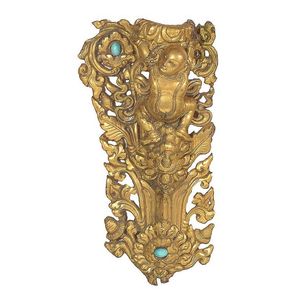Gilded 16th Century Boy Caryatid with Turquoises
You must be a subscriber, and be logged in to view price and dealer details.
Subscribe Now to view actual auction price for this item
When you subscribe, you have the option of setting the currency in which to display prices to $Au, $US, $NZ or Stg.
- Gilding - Gilding is a method of ornamentation whereby a thin sheet of gold metal is applied to items made of wood, leather, ceramics, glass and silver for decorative purposes.
For furniture including mirrors, the sheet of gold is usually applied over a coating of gesso. Gesso is a mixture of plaster of Paris and gypsum mixed with water and then applied to the carved wooden frames of mirrors and picture frames as a base for applying the gold leaf. After numerous coats of gesso have been applied, allowed to dry and then sanded a coat of "bole", a usually red coloured mixture of clay and glue is brushed on and allowed to dry, after which the gold leaf is applied. Over time parts of the gilding will rub off so the base colour can be seen. In water gilding, this was generally a blue colour, while in oil gilding, the under layer was often yellow. In Victorian times, gilders frequently used red as a pigment beneath the gold leaf.
Metal was often gilded by a process known as fire gilding. Gold mixed with mercury was applied and heated, causing the mercury to evaporate, the long-term effect of which was to kill or disable the craftsman or woman from mercury poisoning. The pursuit of beauty has claimed many victims, not the least of which were the artists who made those pieces so highly sought after today. - Caryatid - A Greek term that in architecture applies to a carved or cast female figures that acts as a column or pillar, supporting an entablature on her head.
In decorative arts , in furniture of the Renaissance and Classical Revival periods. Male figures are known as Atlantes.
Carved figures are rare on Australian furniture until the later 19th century, Australian craftsmen generally preferring to adopt the designs of the pattern books to rather more simple forms, such as scrolls or columns.
This item has been included into following indexes:
Visually similar items

An archaistic ivory pendant of rounded rectangular form, one side carved with an inscribed central cartouche within bird motifs in relief on a ground of stylised waves, the reverse undecorated, the ivory stained to an amber colour 6.2 cm

A Tibetan gilt copper repousse plaque, circa 18th century, depicting a bearded deity riding a snow lion, 20 cm high

Large silver ornate cameo brooch, 29.3 grams

A Dayak baby carrier, in classic form with carved ancestral motif to rear, minor chips to base, baby carriers or 'Ba' were used to carry infants, whose souls were believed might wander, and therefore render the baby susceptible to illness or disease, the f
